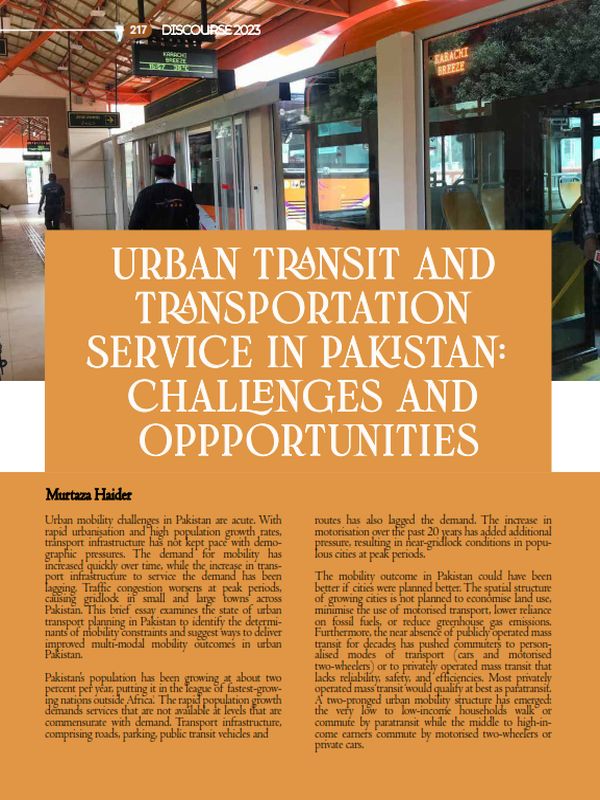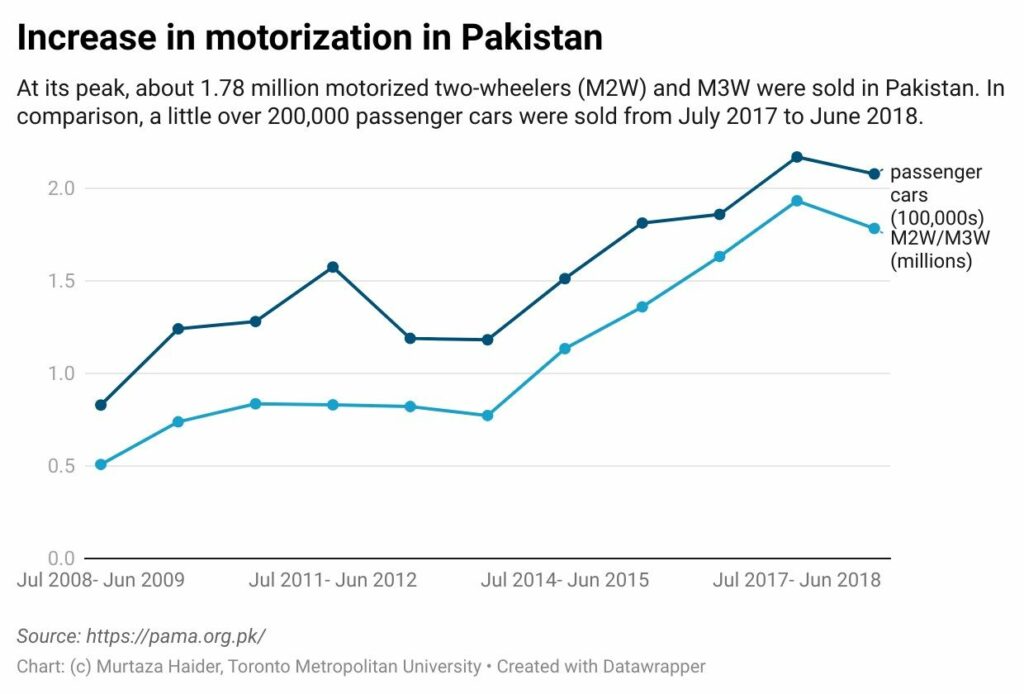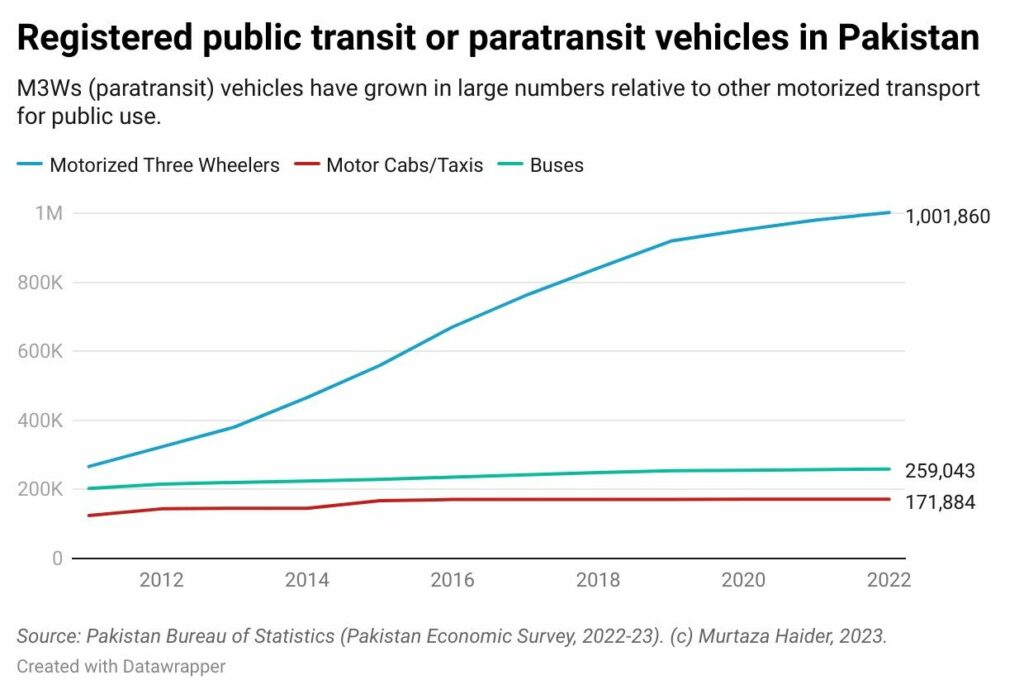
Pakistan Institute of Development Economics
- Home
Our Portals
MenuMenuMenuMenuMenuMenuMenu - ResearchMenuMenuMenuMenuMenuMenuMenu
- Discourse
- The PDR
- Our Researchers
- Academics
- Degree Verification
- Thesis Portal
- Our Portals
Urban Transit and Transportation Service in Pakistan: Challenges and Opportunities
Urban mobility challenges in Pakistan are acute. With rapid urbanisation and high population growth rates, transport infrastructure has not kept pace with demographic pressures. The demand for mobility has increased quickly over time, while the increase in transport infrastructure to service the demand has been lagging. Traffic congestion worsens at peak periods, causing gridlock in small and large towns across Pakistan. This brief essay examines the state of urban transport planning in Pakistan to identify the determinants of mobility constraints and suggest ways to deliver improved multi-modal mobility outcomes in urban Pakistan.
Pakistan’s population has been growing at about two percent per year, putting it in the league of fastest-growing nations outside Africa.[1] The rapid population growth demands services that are not available at levels that are commensurate with demand. Transport infrastructure, comprising roads, parking, public transit vehicles and routes has also lagged the demand. The increase in motorisation over the past 20 years has added additional pressure, resulting in near-gridlock conditions in populous cities at peak periods.
The mobility outcome in Pakistan could have been better if cities were planned better. The spatial structure of growing cities is not planned to economise land use, minimise the use of motorised transport, lower reliance on fossil fuels, or reduce greenhouse gas emissions. Furthermore, the near absence of publicly operated mass transit for decades has pushed commuters to personalised modes of transport (cars and motorised two-wheelers) or to privately operated mass transit that lacks reliability, safety, and efficiencies. Most privately operated mass transit would qualify at best as paratransit. A two-pronged urban mobility structure has emerged: the very low to low-income households walk or commute by paratransit while the middle to high-income earners commute by motorised two-wheelers or private cars.
Over the past two decades, public and private entities have taken steps to improve mobility outcomes in urban Pakistan. These include increasing lane kilometres in urban areas to accommodate population growth and, where possible, introducing grade separation to separate traffic at high-volume roads and intersections. Some provincial governments took steps to improve public transit supply by introducing bus franchise schemes that attracted private investors to operate standardised, high-quality bus transit services on urban routes. Other public sector initiatives included standalone BRT routes without feeder networks and planning for rail-based regional transit. The private sector followed the Western shared mobility models and launched Transport Network Companies (TNCs), such as Careem and Uber, and on-demand transit services, such as the now discontinued Swvl and Airlift.
A series of missteps, including judicial overreach and lack of local governments in Pakistan, implied that public sector projects either failed to reach scale or were planned to fail or delivered only partial solutions. Meanwhile, public sector bureaucratic high-handedness created hurdles in the way of privately operated mass transit in Pakistan, forcing many out of business.
The Elephants in the Room
There are at least two major structural impediments to urban spatial and transport planning in Pakistan. First is the missing local government set up that is necessary for delivering municipal services, such as water supply, waste collection, and transportation services. Second is the presence of military cantonments embedded in the urban spatial fabric where unelected officials make decisions about urban and transport planning.
The failure of transport planning in general and transit planning in particular is a direct result of the missing municipal governments in Pakistan. Elected municipal governments have not functioned except for a few years in Pakistan. Even when they existed, the severely constrained own-source revenue generation mechanisms prevented municipal governments from delivering mobility solutions. The tussle between civil and military establishments in Pakistan has contributed to the challenge of missing governments. The political elite in Pakistan has tried to subdue local governments by either not holding elections for local governments or starving them for resources where the municipal governments have existed. Local governments have flourished under military regimes that created the third tier of political leadership, hoping that the municipal leaders empowered under the military rule will be sympathetic to military governments. The net result was that the local governments enabled under military rule were quickly dismantled under civilian governments.
As a result, the past few decades have been characterised by strong provincial governments doubling as local governments that assumed transport and urban planning roles through project-based entities run by bureaucrats. Hence, the spatial structure and evolution of large cities evolved haphazardly, facilitated by urban planning authorities that did not report to local governments. Furthermore, transportation infrastructure projects, largely funded by provincial and federal governments, were implemented by provincial governments without any local input. Hence, the construction of overpasses and underpasses, the widening of municipal roads, and the construction of ring roads are examples of infrastructure investments in urban centres without any real and meaningful input from either the citizens or the local government representatives who have been missing.
The urban and transport planning in military cantonments is a top-down bureaucratic exercise where the executive authority rests with unelected officials who report directly or indirectly to military land and cantonments under the Ministry of Defence. Currently, there are 44 cantonments across Pakistan where nonelected officials perform local government functions. Since these cantonments are part and parcel of the neighbouring or surrounding urban structures, a seamless integration of municipal services, especially for transportation, is necessary. However, given the separate governance structure, a lack of integrative planning is the default outcome.
In places where transport planning, especially public transit service delivery works exceptionally well, the service is delivered by local governments. Consider Toronto, where The Toronto Transit Commission operates the public transit service comprising underground subways, buses, and streetcars, which carried millions of daily passengers before the pandemic. The commission reports to the city authorities while it independently makes operating decisions about delineating transit routes, frequency of service, and other operating decisions. Other successful models of public transit service delivery in London, Berlin, and Chicago are examples of local and regional governments planning and delivering transit service. Hence, it is imperative that the civil and military elite in Pakistan recognise that top-down models of successful municipal service delivery do not exist and perhaps the sorry state of miserable service delivery in Pakistan is a direct result of the continued refusal to empower local governments.
In addition to military and civil establishments undermining the authority of local governments to deliver municipal services, the superior judiciary has also been instrumental in interfering in municipal planning matters, worsening public transport service delivery. The bus franchise scheme, as discussed earlier, introduced thousands of standardised public transit vehicles across Pakistan for planned and efficient transit services. The operators of unsafe paratransit establishments approached the Supreme Court, led by Chief Justice Iftikhar Chaudhry. Instead of dismissing the petition by the operators of unsafe and unplanned transit services, the Supreme Court sided with them, declaring the provincial bus franchise as acting beyond the ambit of the Constitution. This is akin to guaranteeing quacks the right to practice medical procedures because forbidding them from operating on unsuspecting patients will be denying them the right to earn a living. The unwise decision by the Supreme Court single-handedly put transit planning and service delivery in the hands of transit mafias who have operated unplanned, unscheduled, and unsafe transit across Pakistan.
Mobility in Urban Pakistan Today
Given the lack of urban spatial and transport planning, it is no surprise that motorised modes of transport dominate mobility in Pakistan. The lack of public transit infrastructure and the absence of bike lanes and sidewalks imply that public transit and non-motorised mode share are negligible in Pakistan. Often, it is argued that the mobility landscape in Pakistan is dominated by passenger cars. This is not true for Pakistan, while it is the case in most Western metropoles. Given the prevalence of low to mid-income households in urban Pakistan, passenger cars are outside the affordable reach of the majority who instead rely on motorcycles and other similar modes, also known as motorised two-wheelers (M2W) for their mobility needs. Figure 1 illustrates the point that whereas 4.3 million vehicles characterized as cars, jeeps, and station wagons were registered in Pakistan in 2022, M2Ws registrations at 27 million units eclipsed passenger cars.
Figure 1. Number of Registered Motor Vehicles in Pakistan
Since 2008, passenger car sales have increased, reaching a peak of almost 200,000 sales in 2017–18 (Figure 2). At the same time, the sale of motorised two-wheelers and motorised three-wheelers (M3W, paratransit vehicles such as rickshaws) reached 1.8 million, further providing evidence that passenger cars constitute a small portion of the vehicular makes in urban Pakistan, where M2Ws and M3Ws dominate. This is also evidenced by a cursory look at busy intersections across urban Pakistan, where hundreds of two-wheelers punctuate the road space, carrying far more commuters than passenger cars.
Figure 2. Increase in Motorisation in Pakistan
In the absence of proper public transit facilities, paratransit service providers such as rickshaws and Qing-Qis, emerged, offering less than adequate, unsafe, and highly inefficient transit services. Figure 3 depicts the rapid increase in M3Ws from 2011, when their number was slightly higher than that of buses, reaching over one million units by 2022. Hence, M3Ws dominate public transit services in urban Pakistan, even in cities where BRT services are available. Since BRT operates on a standalone route without a feeder network in all urban implementations, M3Ws are the primary mode for access from and egress to BRT. At the same time, since most of the urban destinations are not served by BRT, M3Ws are the frequently used alternative.
Figure 3. Registered Public Transit or Paratransit Vehicles in Pakistan
The Private Sector Innovates
The emergence of transport network companies in North America and Europe provided a model for workable mobility solutions for middle and upper-class commuters in Pakistan. As a result, Uber and Careem started operations in Pakistan, providing reliable and efficient mobility services, capitalising on the innovations in mobility made possible by information and communication technologies. Furthermore, the innovations in on-demand transit, such as Airlift, also hold promise. While the services are commendable for the markets they serve, they still are out of reach for most low-income commuters. Therefore, there remains a need for the public sector to provide efficient and affordable public transit alternatives for low-income commuters and subsidised transit for the lowest-income households.
The Path Ahead
Establishing and empowering local governments for urban spatial structure planning and delivery of municipal services, including public transit, is paramount for Pakistan. Furthermore, dissolving the cantonments to merge with the cities is critical to removing artificial that prohibit planning and service delivery in Pakistan. The administrative overreach by higher tiers of governments, Military Lands and Cantonments, and superior judiciary should be ceased immediately for city planning to be in the hands of local governments and planners who respond directly to local authorities.
The innovative solutions brought about by the private sector that serve the mobility needs of those who can afford them, should be encouraged and facilitated instead of subjecting them to unnecessary, and often punitive, bureaucratic hurdles.
Urban transportation planning requires data and analytics, which do not exist in Pakistan. The lack of data and analytics is evident from the fact that transportation mode shares are not known for any city, big or small, in Pakistan. Since the data points are missing, so are the analytics. This lack of knowledge needs immediate attention. Despite the mushroom growth in higher education programs focusing on urban planning, civil engineering, and even traffic engineering, the lack of data and necessary analytical tools suggest that Pakistan is training its future experts with data blindfolds.
Transport planning data needs could be addressed by two practical approaches. First, the ubiquitous use of smartphones could be a resource in capturing passive data for detecting trip origins, trip destinations, trip start time, commute duration, and travel speed. Such data may be missing the necessary demographic attributes of commuters, their specific modes of travel, and other details. However, such data could be the first building block towards urban data repositories that can assist with transport and transit planning.
The second necessary step is to include journey-to-work questionnaires in the Census and other large-scale surveys conducted by the federal and provincial governments. The journey to work questionnaire is part of the long-form census in Canada. It is routinely administered in the United States, collecting information about demographics, mode of travel, trip start times in duration, and other relevant details.
Lastly, the mobility needs of the urban poor cannot be met by the innovative mobility solutions provided by the private sector. The public sector must provide affordable and reliable transit services and access to non-motorized modes to the urban poor. One can still strive for innovative solutions to provide affordable mobility alternatives, as is the case at Peshawar University, where the university administration is providing bicycles to students and faculty to commute within the university campus.
Affordable, efficient, reliable, safe, and sustainable mobility solutions are a must for cities in Pakistan to be functional and desirable. Without efficient mobility solutions, cities will be gridlocked, preventing citizens from participating in the socioeconomic spheres while contributing to excessive use of fossil fuels and wasteful generation of greenhouse gas missions.
The author is a Professor at the Ted Rogers School of Management, Toronto Metropolitan University and the Director of Research at the Urban Analytics Institute.
[1] https://www.worldometers.info/world-population/pakistan-population/






